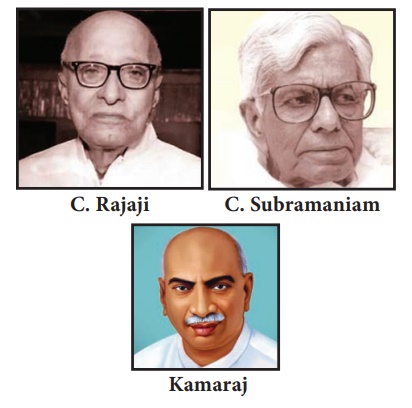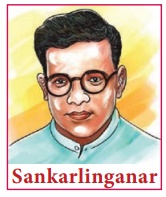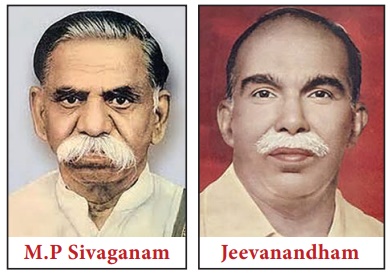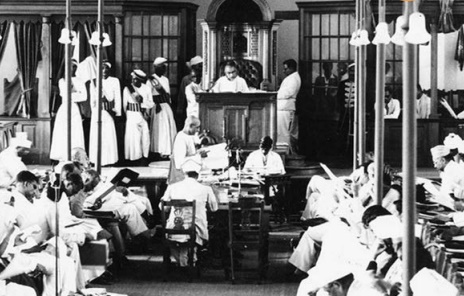Constitution of India | Political Science - Parliamentary Democracy in India | 12th Political Science : Chapter 1 : Constitution of India
Chapter: 12th Political Science : Chapter 1 : Constitution of India
Parliamentary Democracy in India
Parliamentary Democracy in India.
Under Article 79, the Parliament of the Union
consists of the President and two Houses known respectively as the Council of
States (Rajya Sabha) and the House of the People (Lok Sabha). The Union
Legislature is bicameral, and the need for a bicameral system of the
legislature in a federation is admitted: the Upper House represents the units,
the Lower House represents the people; the two Houses respectively functions to
preserve the integrity of the units and to secure the integration of the Union.
The Rules of Procedure and Conduct of Business in Rajya Sabha is the booklet
that provides explicit conduct of its members. There are various discussions
namely: half an hour discussion, short duration discussion and motions of
matters in public interests.
Constructive debates in Tamil Nadu State legislative Assemblys

The first Assembly (1952-1957) under the
constitution of India discussed the scheme of elementary education launched by
the Rajaji Government and criticized by many including a few in the Congress
party that it would perpetuate caste-based social hierarchy. After Kamaraj
succeeded him, Education Minister C. Subramaniam in May 1954 informed the House
that the scheme would be dropped. The Rajaji days are remembered for landmark
laws to protect tenants of farmlands and landless agriculturists.
“Premier of Madras Presidency, C. Rajaji presenting
his first budget in 1937.
Location is Madras Legislative Assembly, Senate
House, Chepauk Campus of Madras University, Date 1937”
In 1967, the Dravida Munnetra Kazhagam came to
power with C.N. Annadurai as Chief Minister. The Hindu Marriage Act was amended
to recognize “self-respect marriages” or those marriages free of religious
rituals. His successor and five-time Chief Minister, M. Karunanidhi, piloted
several Bills and moved numerous motions. In his last bill (2006-2011),
reservation were made for Muslims within the quota of Backward Classes and Arundathiyars
within the reservation of Scheduled Castes.
The 10-year-long rule (1977-1987) of the
Government, headed by M.G. Ramachandran of the All India Anna Dravida Munnetra
Kazhagam, was noted for various measures in the area of revenue administration.
Notably, the system of hereditary village officers such as “karnam” was
abolished at one stroke. He upgraded the mid-day meal scheme into Nutritious
Meal Scheme.
After the Supreme Court delivered the
Mandal Commission judgment in November 1992 for reservation in education and
employment at 50 percent, the Assembly responded through legislation aimed at
safeguarding the existing 69 percent quota for Backward Classes, Most Backward
Classes, Scheduled Castes, and Scheduled Tribes.
Sankarlinganar

Sankarlinganar is a Tamil Indian Independence
activist and Gandhian. He was born in Manmalai Medu in Virudhunagar District to Karuppasamy and
Valliammal in 1895. He joined the Indian National Congress in 1917. He also
participated in the Salt March in 1930 along with Gandhi under Rajaji’s
influence. The consequence of Potti Sreeramalu fast demanding for a separate
state of Telugu from Madras state for Telugu speaking people and Madras city to
be its capital in 1952 led to new agitation in Madras state in need to change
its name.

In 1956, Sankarlinganar started to fast on demand
for change in the name of the state from Madras to Tamil Nadu. He started his
hunger strike on 27th July on 1956 in Virudhunagar for 12 demands. Despite the
request of C.N.Annadurai, M.P Sivaganam, and Jeevanandham, he continued to fast
and died on the 76th day on 13th October 1956.
Select Committee
The Select Committee is made up of a small number
of parliamentary members appointed to deal with particular aspects originating
in the Westminster System of parliamentary democracy.
Under Rule 125 of the Rajya Sabha Rules and
Procedures, any member may move a bill which is referred to a select committee
and, when the motion is admitted, the bill shall be referred to such a
committee.
The quorum needs to be one -third of the total
number of members of the committee. In case of a tie on any matter, the
chairman (or any other person presiding) will cast his vote. The select
committee may appoint a sub-committee to examine any particular points
connected with the bill. If any doubt arises on any aspect of the procedure the
chairman may refer the point to the Rajya Sabha Chairman, whose decision will
be final
Whenever a bill passed by one house is rejected by
another house or any disagreement or more than six months has elapsed, the
President of India may call a joint sitting of the two Houses to resolve the
deadlock. The bill will be passed in both Houses by a majority of the total
number of members of both Houses present and voting. There is no provision in
the Indian Constitution for a joint sitting of both houses on a money bill or a
Constitution Amendment Bill.
First Prime Minister of India Quotable
“Each House has full authority to
regulate its procedure within the limits of the Constitution. Neither House, by
itself, constitutes Parliament. It is the two Houses together that are the
Parliament of India. The successful working of our Constitution, as of any
democratic structure, demands the closest cooperation between the two Houses.”
- Pandit Jawaharlal Nehru
Important Debate:
1st August 2014: Use of Tamil as court
language in Tamil Nadu
Quotable Quote:
“India, that is Bharat, shall be a
Union of States. Article 1(1)”
Tamil Nadu Legislative Assembly
·
Tamil Nadu Legislative Assembly consists of 234 elected Members
from 189 General and 45 Reserved Constituencies.
·
The First Madras Legislative Assembly session was held on 3rd of
May 1952, constituted after the General Elections in 1952.
·
Under Article 333 of the Constitution
of India, the Governor nominates one Member representing from Anglo-Indian Community.
·
The Fifteenth Tamil Nadu Legislative
Assembly was constituted on the 21st May 2016 after the general election to the Tamil Nadu Legislative
Assembly on the 16th May 2016.

Public Accounts Committee
v The Chairperson of the Public
Accounts Committee is appointed by the Speaker from
amongst its Members of Lok Sabha. The Speaker, for the first time, appointed a
Member of the Opposition as the Chairperson of the Committee for 1967-68.
v Since the Committee became a Parliamentary
Committee under the control of the Speaker from January 1950, it has
presented 1596 Reports till April 2018.
Tamil Nadu
v Thiyagi Sankaralinganar observed
fasting for 76 days from 27.07.1956 to
10.10.1956, for the name conversion of Chennai Presidency as “Tamizhagam.”
v The State of Madras changed the name as State of Tamil Nadu on 14th January 1969.
v He was the only person in Indian History to end his life by observing fast for many days in
Gandhiyan Way.
Important joint sittings
v 6 and 9 May 1961 on Dowry Prohibition Bill, 1959.
v 26 March 2002 on Prevention of Terrorism Bill, 2002.
Related Topics